
Guests
- Jonathan Barry-Blockervisiting professor at the University of Florida College of Law whose grandfather was a survivor of the 1923 Rosewood massacre.
As ceremonies mark the 100th anniversary of when a white mob attacked and burned down the Black town of Rosewood, Florida, we look at the largely untold story of how a racist mob murdered at least six Black residents and forced the rest of the town to flee. Many eyewitnesses said the true death toll was far higher. The bloodshed began after a white woman accused a Black man of assault, resulting in several days of violence by the white mob that ultimately destroyed the once-thriving community. We speak with Jonathan Barry-Blocker, whose late grandfather, Reverend Ernest Blocker, was a survivor of the 1923 massacre.
Transcript
AMY GOODMAN: This is Democracy Now!, democracynow.org, The War and Peace Report. I’m Amy Goodman, with Juan González, as we turn to look at the Rosewood massacre.
A hundred years ago this weekend, a white mob attacked and burned down the Black town of Rosewood in central Florida. The racist mob murdered at least six Black residents, forced the rest of the town to flee. Many eyewitnesses said the true death toll was far higher. The violence began after a white woman falsely accused a Black man of assault nearby. By the time the massacre ended, every building in Rosewood except one had burned down. No law enforcement agency investigated the massacre. No one was ever charged with crimes. In 1994, the Florida Legislature approved $2 million in compensation for nine survivors and dozens of descendants of the attack. According to the Southern Poverty Law Center, they were the only government reparations ever paid to victims of this anti-Black racial violence in the U.S.
In a moment, we’ll be joined by a professor whose grandfather survived the Rosewood massacre. But first, this is an excerpt from the trailer to the late director John Singleton’s acclaimed 1997 film Rosewood, which helped bring greater attention to the massacre.
NARRATOR: In 1923, the Black town of Rosewood was a land of opportunity.
AUNT SARAH: [played by Esther Rolle] You’ve been drifting long, Mr. Mann.
MANN: [played by Ving Rhames] Seem like forever.
AUNT SARAH: Colored folks own all the land around here. All the businesses, too. Mann could make a new start around here, make something of himself.
FANNY TAYLOR: [played by Catherine Kellner] Help me!
NARRATOR: Until the day one woman’s false accusation —
SHERIFF WALKER: [played by Michael Rooker] Tell me the truth. Was it true that a colored done this to you?
NARRATOR: — unleashed the fury against their town.
POLY: [played by Mark Boone Junior] If you find him, well, you know what to do.
SYLVESTER CARRIER: [played by Don Cheadle] There be some trouble around here, sir. Could sure use your help.
MANN: There ain’t no way in the world one man got enough bullets for all them crackers.
NARRATOR: And the search for the guilty became a hunt for the innocent.
JOHN WRIGHT: [played by Jon Voight] These are real folks dying. Women and children ain’t done nothing wrong to no soul.
SYLVESTER CARRIER: And colored folk just can’t be running all the time. There comes a time when you’ve got to stand up and defend your rights.
MANN: We’re going to make it. Trust me.
AMY GOODMAN: The trailer to the late great director John Singleton’s 1997 film Rosewood.
We go now to Gainesville, Florida, about 45 miles from Rosewood, where we’re joined by Jonathan Barry-Blocker. He’s visiting professor at University of Florida Law School, former staff attorney with the Southern Poverty Law Center. His grandfather, the late Reverend Ernest Blocker, survived the 1923 Rosewood massacre.
It’s great to have you with us, Professor Barry-Blocker. Welcome to Democracy Now!
JONATHAN BARRY-BLOCKER: Thank you. Good morning.
AMY GOODMAN: Tell us about how you learned about the massacre. And what happened with your grandfather?
JONATHAN BARRY-BLOCKER: Sure. I learned about the massacre when I was 13, but in a very distant, disconnected way. My dad sat me down and said, “Hey, there’s a movie coming out, and people may ask some questions of you about it. Your grandfather was involved, but he’s not going to answer questions, so don’t ask him.” And that was pretty much it, the end of the conversation. And so, I didn’t initiate any communications. My dad has indicated that at some point he forced my grandfather to try to talk to us about it, but I’m told that lasted all of five minutes and was very sparse on details, so didn’t register.
But it wasn’t until college, when I actually watched the movie Rosewood, because my folks didn’t have me and my siblings watch it while we were growing up, that I came to appreciate exactly what happened, or at least the gist of what happened. And so, I don’t know my grandfather’s role. I don’t know where he was during all the violence and the mayhem. I just know that he and his family left after it and never talked about it again, at least not amongst — not with us.
AMY GOODMAN: And what was your reaction, Jonathan Barry-Blocker, when you saw this film in college, not having known the story your entire growing up?
JONATHAN BARRY-BLOCKER: Oh, I was irate. I was very upset to see it depicted — the terror, the fleeing, the confusion, the displacement. I did not leave campus for the entire weekend.
JUAN GONZÁLEZ: And from what you know, how were the facts documented and uncovered that led to Florida lawmakers approving a first-time compensation or reparations to survivors here?
JONATHAN BARRY-BLOCKER: As I understand things, a journalist, Gary Moore, broke the story in the '80s. And then, one of the descendants, Arnett Doctor, pushed and advocated for compensation and reparations, and mobilized a lot of folks to support him in that effort. And that's what led to the study and then, eventually, to the compensation package, or, as what we might call it, reparations, for some of the descendants and survivors.
AMY GOODMAN: Let me turn to a clip. This is historian Robin D. G. Kelley of UCLA. In 2020, he appeared on Democracy Now! to talk about the history of race massacres in the United States.
ROBIN D. G. KELLEY: If you look at the history of race riots in America, most so-called race riots were basically pogroms, going back to Cincinnati in 1839, 1841, going back to a whole range of so-called race riots in Philadelphia. You mentioned Tulsa in the opening of the show, Tulsa, Oklahoma, which was a kind of looting — not a kind of looting, but you’re talking about destroying 35 blocks of Black-owned property and businesses worth millions of dollars, people going into people’s — white people going into homes, with the support of the police, taking Black people’s stuff, destroying and taking stuff. Tulsa, Oklahoma, East St. Louis in 1917 — we could talk about Rosewood in 1923. You know, there’s so many examples — Springfield, Illinois, in 1908. And some of that looting is also about taking political power.
AMY GOODMAN: Professor Barry-Blocker, if you can comment on what Robin D. G. Kelley had to say? And also, as someone who has worked on poverty and race relations and violation of human and voting rights in this country at Southern Poverty Law Center, what about this discussion of reparations? I mean, $2 million that the Legislature approved, of course, is a pittance when you’re talking about the loss of human life and the rest of the effect, the terror effect, on the Black population of Florida.
JONATHAN BARRY-BLOCKER: All right, well, you’ve got two questions there, so I’ll try to remember each. Remind me if I forget any part of one.
But in regards to your first question, what the professor was saying, I want to be upfront. Mass violence, racial violence is not my research area, but I do incorporate it into my lessons. And it was widespread. And as was heard on the clip, it could be deployed to gain political power, in retribution to perceived slights to white womanhood, or for too much economic prosperity or economic competition. And so, it happened to Blacks. It happened to Indigenous communities, happened to Filipino and other Asian American communities on the West Coast, as well as Hispanic communities during the 18th and 20th century — or, 19th and 20th centuries. So, it’s prevalent in the histories of — the annals of American history. And I would encourage everyone to read up and discover more of what was going on in not just their bloodlines, but even their communities, their home states or their homelands, if you’ve traveled across the nation or moved.
With regards to your second question, having worked in poverty work and civil rights work with SPLC and Legal Services Alabama, and the call for reparations, I think the government has failed to protect sometimes communities here and its citizens, or has aided in harms to certain communities and citizens. And so, there does need to be talk about how to repair those harms, especially if they’re long-standing and long-lasting. Our legal system — someone brought up the question to me once whether or not reparations was proper or valid. And I had to remind them that our legal system in America is built on the concept that you should receive some type of money or repair, financial repair, for harm suffered to your property, to your person, to your marriage, to your emotions, to your family, to your prospects. The law goes a great deal, the tort law here, to repair harm. So I think reparations could be part of that consideration.
JUAN GONZÁLEZ: And, Professor, to what extent has — to your knowledge, has the Black community of Rosewood rebounded? And what’s the status of the community now? Because, obviously, a lot of people were driven out back in 1923. What’s your sense of the situation today?
JONATHAN BARRY-BLOCKER: Well, if you talk to some of the scholars who have made Rosewood their primary focus, you’ll learn that there was a mass exodus of Black residents both in Rosewood and in some of the surrounding towns, like Cedar Key. Cedar Key, which is nine miles away, had a population of roughly 37% Blacks prior to the violence, and afterwards they all but disappeared. So, when you go there now — the times I’ve visited, I have not encountered too many Black locals, either in Cedar Key, and I’ve only been to Rosewood twice. It’s pretty rural now. So, there isn’t a large or robust Black presence, and most people have moved on and did move on to other communities where they felt a bit safer and stable.
AMY GOODMAN: Jonathan Barry-Blocker, we thank you so much for being with us, visiting professor at University of Florida Law School. His grandfather, the late Reverend Ernest Blocker, is a survivor of the 1923 Rosewood massacre, 100 years ago this month.
Next up, we speak with the former head of the NAACP, Ben Jealous. He has a memoir out, Never Forget Our People Were Always Free: A Parable of American Healing. Stay with us.
[break]
AMY GOODMAN: “Look Down, Lord” by John Williams, from the soundtrack of the acclaimed film Rosewood.

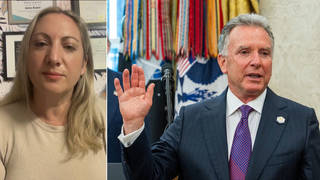
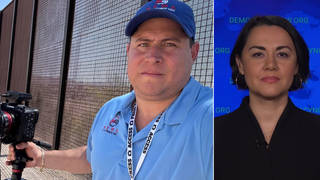
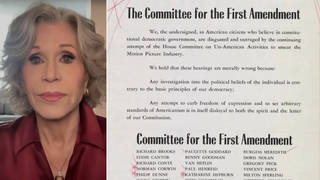



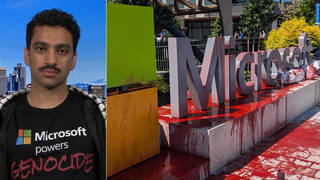
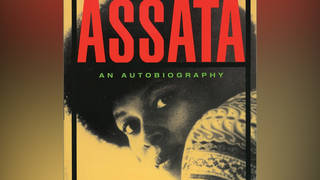

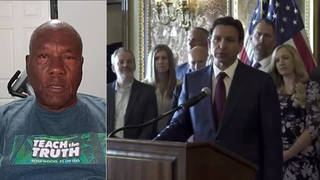
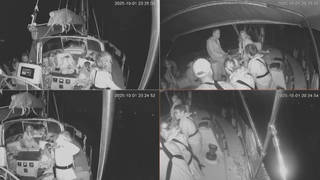
Media Options